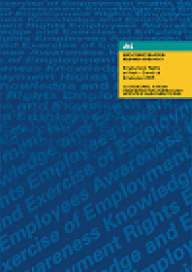Publications
 We author and publish a range of resources to keep you up to date with the latest developments in employment, labour market and human resource policy and practice.
We author and publish a range of resources to keep you up to date with the latest developments in employment, labour market and human resource policy and practice.
All our pdf publications are free to access.
Search results
-
📄
Well-being and Call Centres
Akroyd K, Gordon-Dseagu V, Fairhurst P | Sep 2006 | Institute for Employment StudiesThe number of people working in call centres within the UK has been increasing dramatically in recent years. At the same time, there has been a growing awareness that the work can be stressful and repetitive with little individual discretion. This report seeks to understand why, and in what ways, call centre employment can reduce employees' well-being. It also details practices and research findings that suggest ways to positively influence the well-being of workers.
-
📄
Organisational Justice
Baldwin S | Sep 2006 | Institute for Employment StudiesThe term 'organisational justice' refers to the extent to which employees perceive workplace procedures, interactions and outcomes to be fair in nature. These perceptions can influence attitudes and behaviour for good or ill, in turn having a positive or negative impact on employee performance and the organisation's success.
-
📄
Managing Absence Effectively
Sue Hayday | Aug 2006 | Institute for Employment StudiesVirtually all organisations have absence management policies in place but absence continues to cost the UK economy many millions of pounds each year. There is some debate about whether the approach to tackling absence should be punitive or well-being focused. This paper investigates the causes of absence and demonstrates how to achieve a successful absence management policy.
-
📄
Third Work-Life Balance Employees' Survey
(Revised Edition with corrected figures)
Hooker H, Neathey F, Casebourne J, Munro M | Jul 2006 | Department of Trade and IndustryThis report presents findings from the third Work-Life Balance Employee Survey, conducted in early 2006 amongst employees of working age living in Great Britain working in organisations with five or more employees at the time of the survey. The research was undertaken by IES in partnership with ICM Research. Using computer-assisted telephone interviewing, 2,081 telephone interviews were conducted in February and March 2006.
-

Impact Evaluation of Five Steps to Risk Assessment
Neathey F, Sinclair A, Rick J, Ballard J, Hunt W, Denvir A | Jun 2006 | Health and Safety ExecutiveThis report, which presents an evaluation of the impact of the HSE's Five Steps to Risk Assessment leaflet as well as the Five Steps approach more generally, is based on survey and case study research on risk assessment behaviour in establishments across Great Britain.
-
📄
Evaluation of the Safe Learner Pilot
Miller L, Hunt W | Jun 2006 | Institute for Employment StudiesIn 2005 IES was commissioned by the LSC to determine the extent to which its safe learner model was successful in raising learner awareness and knowledge about health and safety. This document reports the design, conduct and outcomes of that evaluation of the impact of the pilot on learner knowledge.
-
📄
Watching Me, Watching You
the Search for Safe Supervisory Practice
Miller L, Jagger N | May 2006 | Institute for Employment StudiesThis research indicates that the types of factors identified within models of safety culture are present in good practice organisations, although not all aspects were present in each organisation. Perhaps of more importance is the fact that the research revealed that safety culture theory largely ignores issues to do with the development of health and safety awareness and responsibilities in learners in the workplace and training locations. Given that these are among the most vulnerable individuals this omission needs to be addressed.
-

The UK Veterinary Profession in 2006
The Findings of a Survey of the Profession Conducted by the Royal College of Veterinary Surgeons
Robinson D, Hooker H | May 2006 | Royal College of Veterinary SurgeonsThis report presents the results of the 2006 Survey of the Profession, carried out on behalf of the Royal College of Veterinary Surgeons (RCVS). The 2006 survey is the fourth survey carried out by the RCVS. The membership was also surveyed in 1998, 2000 and 2002. Throughout this report, where possible and appropriate, results are compared with those of previous surveys. The aim of these membership surveys is to provide RCVS, and other interested parties, with an evidence-based view of the veterinary profession and the changes taking place within it.
-
📄
Working together
Embedding Good Employment in Public Services
Apr 2006 | CBIGood employment goes hand in hand with good service standards. For most public service users, contact with an employee is the service they receive. Employment practices that help employees excel are therefore vital to delivering world-class public services. The companies included in this report all saw good employment practice as a priority and sought to create environments where employees felt motivated, valued and involved. This report was based on research by IES. This publication is no longer available.
-

Employment Rights at Work
Survey of Employees 2005
Casebourne J, Regan J, Neathey F, Tuohy S | Mar 2006 | Department of Trade and IndustryThe main aims of the study were: to assess employees' general awareness of the scope of their employment rights; for selected topics, to establish employees' knowledge of specific employment rights provision (eg level of the National Minimum Wage(NMW), qualifying period for taking action on the grounds of unfair dismissal and discrimination cases, and rules for the award of costs in employment tribunal cases); to find out the main sources of information and professional advice about employment rights issues and, when employees have had a recent problem (eg in the past five years), where they sought advice and guidance and what they did to try and resolve the problem; and to identify the personal and employment characteristics that influence employees' levels of awareness, knowledge and preparedness to seek advice and take action to enforce their individual employment rights (including employment status).
